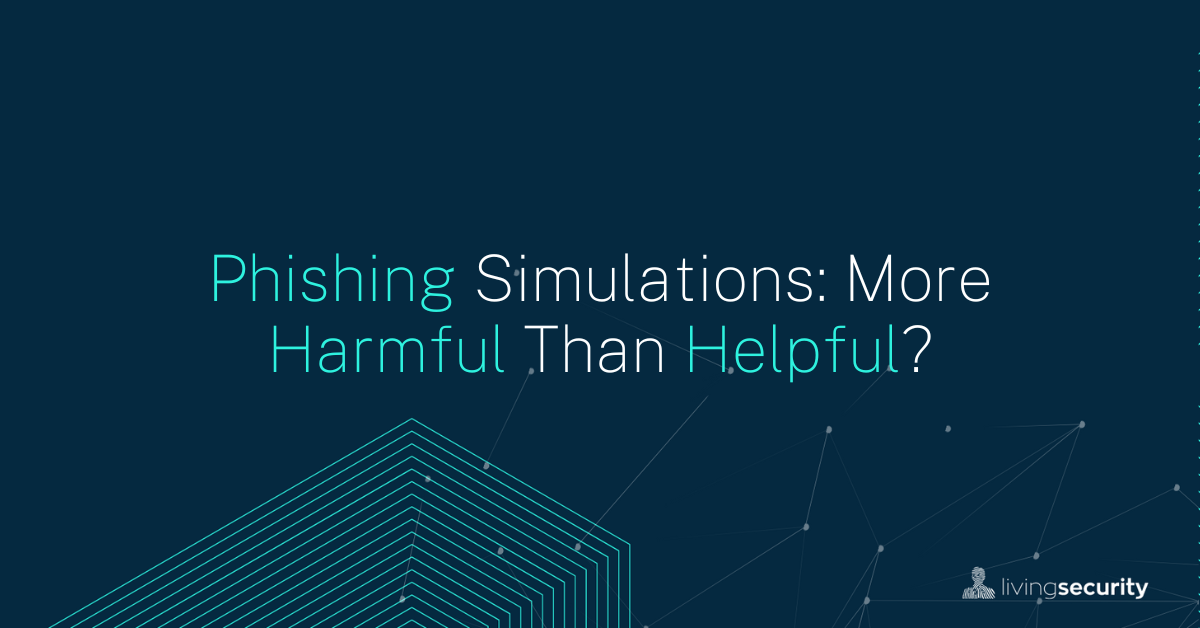

Blogs 
January 29, 2024
Living Security Team
Phishing Simulations: More Harmful Than Helpful?

Cybersecurity threats are an ever-present and growing concern. Phishing attacks, deceptive attempts to steal confidential information by posing as a trustworthy entity, are particularly insidious.
Companies, ever aware of these threats, have gravitated toward an interesting solution for employee risk management: phishing simulations. On paper, the idea is commendable—simulate a phishing scenario and teach employees the nuances of recognizing and responding to genuine phishing attempts. In theory, phishing simulations should simultaneously help train employees to recognize and avoid phishing attacks, while also providing insight to the organization regarding concepts or individuals that may need additional or more specific training.
It’s not really that simple, though. New revelations from various studies and expert opinions are raising pertinent questions about the actual effectiveness of such training. There is an intricate landscape of scenarios where these simulations might, in fact, be counterproductive.
The Faulty Premise of Phishing Simulations
At the core of phishing simulations lies a seemingly reasonable assumption: by acquainting employees with fake phishing emails, they would naturally become adept at spotting the real ones. However, reality offers a more complex picture.
A study spotlighted by TechRepublic presents an unsettling finding. Contrary to expectations, employees who consistently detect fake phishing emails during simulations may develop an overconfidence bias. They begin to believe that real threats will mirror the characteristics of the simulated ones, leading to a dangerous complacency. Thus, the very tool meant to safeguard against threats might be nurturing a false sense of security.
An Unintended Climate of Anxiety and Mistrust
Imagine a workplace where every email click might be a potential trap. An unending barrage of phishing simulations can induce significant stress and anxiety among employees. The promise of a digital environment, where collaboration and communication should be seamless, gets overshadowed by an omnipresent fear of falling prey to a mock attack.
Moreover, there's an even subtler, corrosive effect. The relationship between employees and IT departments, ideally built on trust and collaboration, can begin to fray. Employees, instead of viewing their IT counterparts as allies safeguarding the organization's digital frontiers, might perceive them as adversaries setting up snares. This misalignment is detrimental to fostering a cohesive, united front against genuine cyber threats.
The Ambiguous Nature of Modern Digital Communication
The digital age, while offering unparalleled connectivity, also presents a peculiar challenge when it comes to employee risk management. The line demarcating genuine communications from malicious ones is increasingly blurry. To complicate things further, genuine emails—whether they're about password resets, software updates, or even benign marketing messages—can be eerily similar to phishing attempts.
For an employee, especially one trained via repeated phishing simulations to be ultra-cautious, this poses a dilemma. The result? Critical communications might be inadvertently ignored or discarded. Such missteps not only hinder smooth operations but also open up avenues for actual security breaches if vital updates or actions are sidelined.
Simulations and the Erosion of Organizational Trust
Organizational culture and morale are intangible assets, often cultivated over years. Yet, they can be surprisingly fragile, susceptible to seemingly innocuous internal practices. Phishing simulations, when executed without due sensitivity, can be one such practice.
Imagine the disillusionment an employee feels when an email that promises a long-awaited company bonus turns out to be a phishing simulation test. It’s a double-negative. Not only did the employee not receive the perk or bonus they were anticipating and feel they deserve, but they have also not been flagged for failing a phishing test. Such approaches can breed feelings of betrayal.
When employees start doubting the genuineness of internal communications, the ripple effects can be profound, impacting teamwork, collaboration, and overall morale.
Beyond Simulations: The Wider Cybersecurity Landscape
While phishing is a formidable threat, the threat landscape is filled with myriad challenges. An over-reliance on phishing simulations can lead organizations down a tunnel-visioned path. Cyber threats, from malware to ransomware and beyond, demand a multifaceted defensive strategy. Organizations risk leaving themselves vulnerable if they singularly fixate on phishing at the expense of other threat vectors.
More Harm Than Good
Phishing simulations, despite their noble intent, seem to be ensnared in a web of unintended consequences. As organizations grapple with the ever-changing landscape of cybersecurity threats, there's a pressing need to re-evaluate and recalibrate phishing training methodologies and embrace better employee risk management strategies.
It's time to transition from isolated drills to fostering a culture where cybersecurity awareness is woven into the very fabric of daily operations.
Rethinking Cybersecurity Awareness Training
The cybersecurity community is evolving, and so must its strategies. Organizations need to shift perspective: from isolated tests and simulations to holistic cybersecurity training paradigms.
Cybersecurity awareness training should be a continuous journey, grounded in education, trust, and open channels of communication. Instead of punitive measures that penalize employees for missteps during simulations, a more constructive feedback mechanism, focusing on support and guidance, can make a world of difference.